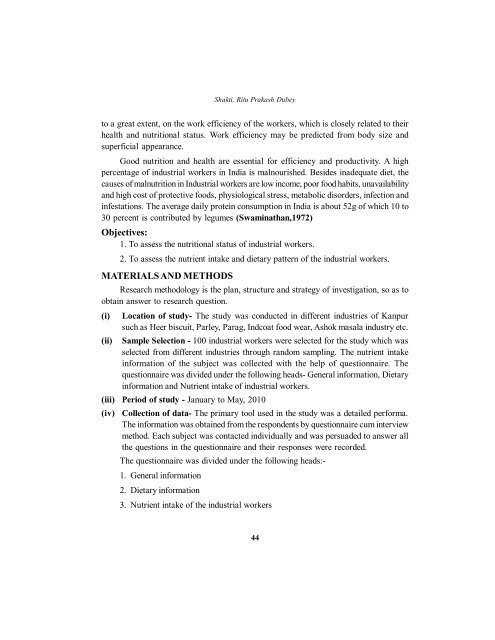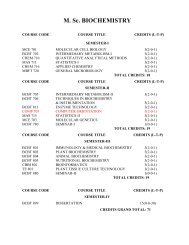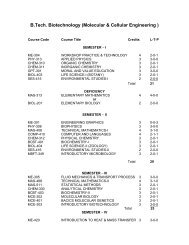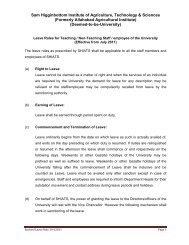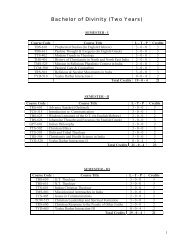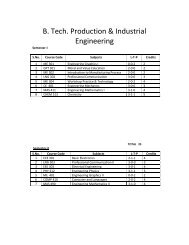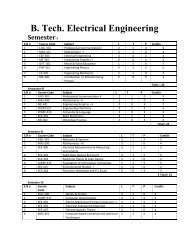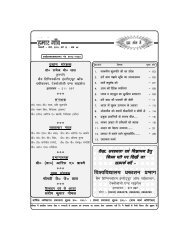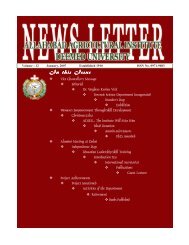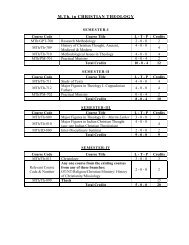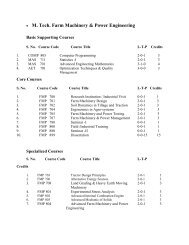Study of Hygienic practices of street food vendors in ... - Shiats.edu.in
Study of Hygienic practices of street food vendors in ... - Shiats.edu.in
Study of Hygienic practices of street food vendors in ... - Shiats.edu.in
You also want an ePaper? Increase the reach of your titles
YUMPU automatically turns print PDFs into web optimized ePapers that Google loves.
Shakti, Ritu Prakash Dubeyto a great extent, on the work efficiency <strong>of</strong> the workers, which is closely related to theirhealth and nutritional status. Work efficiency may be predicted from body size andsuperficial appearance.Good nutrition and health are essential for efficiency and productivity. A highpercentage <strong>of</strong> <strong>in</strong>dustrial workers <strong>in</strong> India is malnourished. Besides <strong>in</strong>adequate diet, thecauses <strong>of</strong> malnutrition <strong>in</strong> Industrial workers are low <strong>in</strong>come, poor <strong>food</strong> habits, unavailabilityand high cost <strong>of</strong> protective <strong>food</strong>s, physiological stress, metabolic disorders, <strong>in</strong>fection and<strong>in</strong>festations. The average daily prote<strong>in</strong> consumption <strong>in</strong> India is about 52g <strong>of</strong> which 10 to30 percent is contributed by legumes (Swam<strong>in</strong>athan,1972)Objectives:1. To assess the nutritional status <strong>of</strong> <strong>in</strong>dustrial workers.2. To assess the nutrient <strong>in</strong>take and dietary pattern <strong>of</strong> the <strong>in</strong>dustrial workers.MATERIALS AND METHODSResearch methodology is the plan, structure and strategy <strong>of</strong> <strong>in</strong>vestigation, so as toobta<strong>in</strong> answer to research question.(i)(ii)Location <strong>of</strong> study- The study was conducted <strong>in</strong> different <strong>in</strong>dustries <strong>of</strong> Kanpursuch as Heer biscuit, Parley, Parag, Indcoat <strong>food</strong> wear, Ashok masala <strong>in</strong>dustry etc.Sample Selection - 100 <strong>in</strong>dustrial workers were selected for the study which wasselected from different <strong>in</strong>dustries through random sampl<strong>in</strong>g. The nutrient <strong>in</strong>take<strong>in</strong>formation <strong>of</strong> the subject was collected with the help <strong>of</strong> questionnaire. Thequestionnaire was divided under the follow<strong>in</strong>g heads- General <strong>in</strong>formation, Dietary<strong>in</strong>formation and Nutrient <strong>in</strong>take <strong>of</strong> <strong>in</strong>dustrial workers.(iii) Period <strong>of</strong> study - January to May, 2010(iv)Collection <strong>of</strong> data- The primary tool used <strong>in</strong> the study was a detailed performa.The <strong>in</strong>formation was obta<strong>in</strong>ed from the respondents by questionnaire cum <strong>in</strong>terviewmethod. Each subject was contacted <strong>in</strong>dividually and was persuaded to answer allthe questions <strong>in</strong> the questionnaire and their responses were recorded.The questionnaire was divided under the follow<strong>in</strong>g heads:-1. General <strong>in</strong>formation2. Dietary <strong>in</strong>formation3. Nutrient <strong>in</strong>take <strong>of</strong> the <strong>in</strong>dustrial workers44


